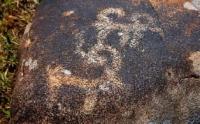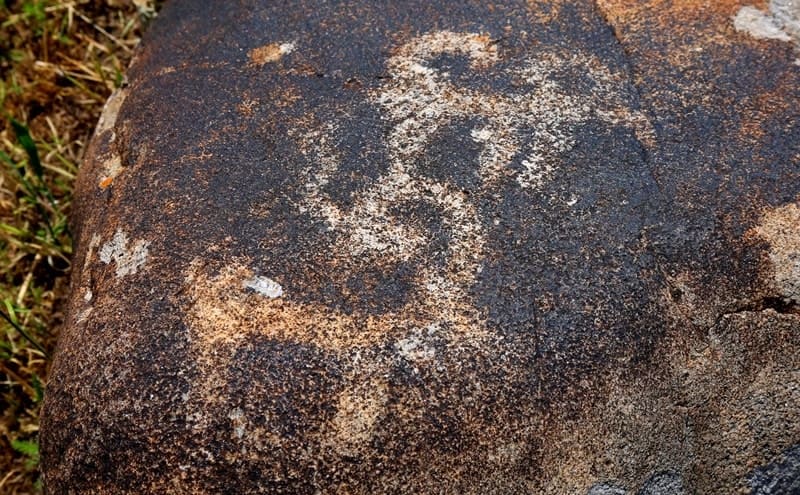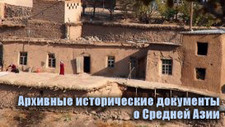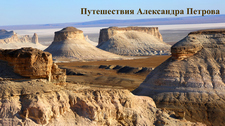You are here
Petroglyphs at Burana settlement.

Adventure tours Kyrgyzstan.
“In its gorges and valleys, the Tien-Shan conceals the memory of the glorious culture of the past. Different peoples lived and created here for thousands of years, and creative cultural life was in full swing here. And no matter how devastating the numerous wars were, the peoples of the Tien Shan left their descendants a great cultural heritage, which a contemporary can rightfully be proud of. The cultural creations created here went to different ancient countries, bringing with them the glory of the hoary Tien Shan, its peoples and its deeds.”
A. N. Bernshtam. “Architectural Monuments of Kyrgyzstan.” 1950.
Museum tours in Kyrgyzstan.
The earliest archaeological monuments from the Issyk-Kul region, which are mentioned in the works of Russian travelers, date back to the Bronze Age. The subjects of the rock art are very diverse: various scenes from the lives of people and images of animals, most often mountain goats.
The botanist A. N. Krasnov, who encountered rock art in the Issyk-Kul region in 1886, reported on them during a joint expedition with I. V. Ignatiev to study Khan-Tengri. F. V. Poyarkov, who visited there in 1887, also wrote about the image of a camel and mountain goats on the rocks in one of the gorges on the southern shore of Issyk-Kul.
The artist S. M. Dudin, V. V. Bartold's companion on his trip to Semirechye in 1893 - 1894, spoke in more detail about the rock paintings of Priisykkulye. In several gorges along the northern shore of the lake, near the Choktal and Cholpon-Ata stations, S. M. Dudin saw "stones with images of goats and other animals."
V. V. Bartold also encountered similar images of "goats and other figures" on large boulders near the Djuukinsky burial ground - on the right bank of the Djuuki (Zauki) River, which flows into Lake Issyk-Kul from the south. S. M. Dudin and V. V. Bartold expressed the correct idea that despite the antiquity of most of the drawings, some images on the rocks are clearly of late origin (XVIIIth - XIXth centuries).
Subsequent studies by Soviet archaeologists confirmed that the chronological range of rock art in Kyrgyzstan stretches from the Bronze Age to modern times. It should be noted that similar drawings are found, in particular (1971), near Kan-Dobe and in the floodplain of the Ton River on sunburnt rocky slopes, as well as on individual boulders of the Tosor plateau.
They are apparently associated with the most ancient ethnic group of the Issyk-Kul region, although they have found imitators in later times.
Authority:
N. Kozhemyako, D. F. Vinnik. "Archaeological Monuments of Issyk-Kul Region". Publishing House "Ilim". Frunze. 1975.
Burana settlement in the Chui Valley of Kyrgyzstan is known primarily for its XIth-century tower - a unique architectural monument of the Karakhanid era. But along with the architectural heritage, there is another treasure here - a collection of stones with petroglyphs collected from different regions of the country.
These images on the stone give the opportunity to touch the deep antiquity and see the world through the eyes of people who lived here thousands of years ago. Petroglyphs are images carved or knocked out on stone. They are among the most ancient forms of artistic expression of mankind.
In Central Asia, such drawings were associated with cult practices, mythology and the everyday life of ancient tribes. Burana has collected stones with petroglyphs dating back to different eras - from the Bronze Age to the early Middle Ages. On the territory of the architectural and archaeological complex Burana Tower there is a separate paved alley with stones on which petroglyphs are depicted.
The petroglyphs are dated to the IInd millennium BC - Xth century AD, the largest number of petroglyphs dates back to the VIIIth - IIIrd centuries. BC, to the Saka period, to the period of residence of the Saka nomads on the territory of Kyrgyzstan.
Origin of stones with petroglyphs at Burana settlement.
The petroglyph collection at Burana is not "local". The stones were brought here from various parts of Kyrgyzstan: from Chui, Issyk-Kul, Naryn and other regions, where rich rock art complexes have been preserved. Thus, Burana has become a kind of open-air museum, where in one place you can see examples of ancient stone art collected from all over the country.
Themes and symbols on petroglyphs of Burana settlement.
The petroglyphs contain a variety of images:
hunting scenes with images of mountain goats, deer, snow leopards;
stylized figures of people and warriors;
solar signs and symbols associated with the cult of nature;
scenes of rituals and sacrifices.
These images reflect the worldview of ancient people, their ideas about nature, space and the place of man in the world. The meaning of the petroglyph collection at the Burana settlement.
Stones collected at Burana perform several functions:
Educational - visitors can get acquainted with the cultural heritage of different regions of Kyrgyzstan in one place.
Scientific - archaeologists and historians use the collection for comparative analysis of styles and subjects of petroglyphs.
Cultural - the stones help to preserve the memory of ancient traditions and show the continuity of Central Asian cultures.
Burana settlement as a center of cultural heritage.
The collection of petroglyphs at the Burana settlement organically complements the architectural and archaeological monuments of this place. The tower, balbals and petroglyphs together form a single historical and cultural complex, where you can trace the history from ancient times to medieval states.
The petroglyphs at the Burana settlement are a unique collection that allows you to see the multifaceted history of Kyrgyzstan through the language of stone images. They turn Burana into a kind of "open-air encyclopedia", where each stone tells about the past, preserving the memory of people and their world.






Authority and photos:
Alexander Petrov.







